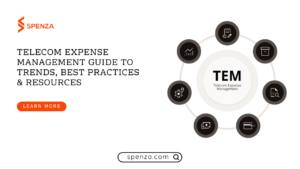Table of Contents
- Introduction
- Why Telecom Expenses Matter
- The Cost of Unmonitored Telecom Spending
- Benefits of a Telecom Expense Audit
- Why Perform a Telecom Expense Audit?
- Detect Billing Mistakes & Overcharges
- Eliminate Unused & Underused Services
- Streamline Contracts & Vendor Arrangements
- Prevent Telecom Fraud & Unauthorized Use
- Improve Budget Management & Cost Estimation
- Telecom Expense Audit Checklist
- Step 1: Collect & Organize Telecom Invoices
- Step 2: Verify Invoice Accuracy & Identify Billing Errors
- Step 3: Analyze Usage Trends & Optimize Service Plans
- Step 4: Review Vendor Contracts & Renegotiate Terms
- Step 5: Conduct an Equipment & Asset Inventory
- Step 6: Implement a Telecom Expense Management (TEM) Solution
- Step 7: Set Up Ongoing Expense Monitoring & Governance
- How Spenza Can Help Optimize Your Telecom Expenses
- Automating Invoice Validation
- Providing Real-Time Usage Insights
- Streamlining Vendor Management
- AI-Driven Cost Optimization
- Final Thoughts
- FAQs
Introduction
Telecom charges usually account for a big percentage of the operational budget of a company but are among the least optimized cost segments. Businesses often end up overpaying for services, carrying old plans, and not capturing cost-reducing options merely because they fail to monitor telecom charges periodically.
A telecom expense audit is a formal procedure that enables businesses to discover errors in billing, remove unwanted fees, negotiate optimal contracts, and enhance general cost efficiency. Be it corporate cellular plans, Internet services, or Voice over Internet Protocol devices, a proper audit can reveal trapped savings and stop wasteful expenses.
In this guide, we will take you through a step-by-step checklist to perform an effective telecom expense audit. Through these best practices, your business can get telecom costs under control, hold vendors accountable, and have a cost management strategy that lasts.
Why Perform a Telecom Expense Audit?
Let’s discuss why a telecom expense audit is crucial for companies of any size before we jump into the audit checklist:
1. Detect billing mistakes and overcharges
Telecom bills are complicated, and mistakes are more prevalent than you realize. Errors like double charges, incorrect rates, and unauthorized services can drive costs through the roof.
2. Eliminate Unused and Underused Services
Most companies still pay for unused phone lines, data plans, and subscriptions. Termination of such services can translate to instant savings.
3. Streamline Contracts & Vendor Arrangements
Telecom providers often launch new pricing schemes and promotions. Companies that do not renegotiate contracts risk being stuck with old, costly plans.
4. Prevent Telecom Fraud & Unauthorized Use
Unlawful telecom activity, such as unauthorized international calling or data consumption, can result in surprise charges. An audit identifies anomalies and possible security threats.
5. Better Budget Management & Cost Estimation
With a clear knowledge of telecom charges, companies are able to manage budgets more efficiently and make rational financial decisions on future investments in telecom infrastructure.
A telecom expense audit is not merely a matter of checking invoices—it’s about having complete visibility into your telecom expenditure, maximizing your usage, and cutting out inefficiencies. What follows is a step-by-step, in-depth guide to assist you in performing a comprehensive audit and maximizing cost savings.
Telecom Expense Audit Checklist
1. Collect and organize telecom invoices
Before analyzing expenses, you need a complete picture of all telecom-related costs. Start by gathering:
- Mobile services – Corporate cell phones, employee plans, roaming charges.
- Internet services – Fiber, broadband, leased lines, satellite internet.
- Voice services – VoIP, landlines, PBX systems, toll-free numbers.
- Cloud-based telecom services – Video conferencing, virtual call centers, remote work communication tools.
- IoT connectivity expenses – SIM cards, connected devices, machine-to-machine (M2M) services.
Best Practices for Organizing Invoices:
- Consolidate all invoices from the past 12–24 months in a digital format for easy reference.
- Store records in a centralized repository (e.g., a shared drive, TEM platform, or accounting software).
- Categorize invoices by vendor, service type, and department to track spending patterns effectively.
- Ensure that contract agreements are stored alongside invoices for quick comparisons.
By organizing invoices efficiently, you streamline the auditing process and reduce the chances of missing any hidden costs.
2. Verify Invoice Accuracy & Identify Billing Errors
Telecom billing errors are surprisingly common and can lead to significant overpayments. A detailed invoice review should include:
Common Billing Errors to Watch For:
- Duplicate Charges – The same service billed multiple times across different months.
- Incorrect Rates – Charges that don’t match your contracted rates or promotional discounts.
- Unapproved Services – Charges for add-ons or services that were never authorized.
- Hidden Fees & Surcharges – Unexplained regulatory fees, maintenance costs, or miscellaneous charges.
How to Detect & Dispute Errors:
- Compare invoices with contract agreements to ensure accurate pricing.
- Use TEM software to automate invoice validation and flag inconsistencies.
- Request detailed breakdowns from vendors to clarify unclear charges.
- Contact providers immediately to dispute errors and request refunds.
Catching even small billing errors can lead to thousands of dollars in recovered costs over time.
3. Analyze Usage Trends & Optimize Service Plans
Once invoices are verified, analyzing actual usage helps determine whether your business is paying for unnecessary services.
Key Usage Areas to Examine:
- Underutilized Lines & Services – Identify inactive SIM cards, phone lines, and accounts with minimal activity.
- Mobile Data & Call Consumption – Ensure that employee plans align with actual usage patterns (e.g., avoid paying for unlimited data if not needed).
- Roaming & International Usage – Check for excessive roaming charges and consider alternatives like eSIM data plans for international business travel.
- Cloud & VoIP Usage – Assess whether all VoIP or cloud communication licenses are actively used.
How to Optimize Plans & Reduce Costs:
- Downgrade unused or underutilized services to lower-cost plans.
- Negotiate bulk discounts if you identify high-volume usage patterns.
- Explore multi-carrier options to ensure you’re using the most cost-effective provider in each region.
By fine-tuning service plans, companies can maximize telecom efficiency while reducing wasteful spending.
4. Review Vendor Contracts & Renegotiate Terms
Many businesses overpay for telecom services simply because they fail to renegotiate their contracts. Telecom providers frequently update pricing plans, offer discounts, and introduce better bundles—but only if you ask for them.
Key Contract Elements to Evaluate:
- Contract Expiration Dates – Identify upcoming renewals and proactively renegotiate.
- Outdated Pricing Plans – Ensure your company is on the best available plan.
- Hidden Clauses & Fees – Scrutinize fine print for unnecessary charges that can be removed.
- Competitive Offers – Research alternative vendors to leverage better pricing.
Negotiation Strategies:
- Benchmark pricing against competitors before negotiating.
- Request volume discounts if you manage multiple accounts or have significant data needs.
- Ask for contract flexibility (e.g., month-to-month agreements instead of long-term lock-ins).
Proactively managing telecom contracts can lead to significant cost reductions over time.
5. Conduct an Equipment & Asset Inventory
Beyond service plans, businesses waste money on outdated or unused telecom hardware.
Inventory Checklist:
- Unused Desk Phones & SIM Cards – Disconnect inactive landlines and employee devices.
- Aging & Obsolete Equipment – Replace outdated PBX systems, routers, and modems with cost-efficient alternatives.
- IoT & Connected Devices – Review M2M SIM card usage to ensure all active devices are necessary.
Cost-Saving Measures:
- Implement device buyback or recycling programs for unused equipment.
- Use cloud-based phone systems (VoIP) instead of physical PBX infrastructure.
- Consolidate telecom hardware across departments to reduce redundant devices.
Keeping telecom assets in check prevents unnecessary capital expenses.
6. Implement a Telecom Expense Management (TEM) Solution
Manually tracking telecom expenses can be overwhelming. A Telecom Expense Management (TEM) platform simplifies the process by automating cost control.
Benefits of a TEM Solution:
- Automated Invoice Processing & Validation – Reduce errors and save time.
- Real-Time Usage Monitoring – Detects anomalies before they become costly mistakes.
- Multi-Carrier Optimization – Compare costs across multiple providers for the best deals.
How TEM Solutions Save Money:
- Eliminate redundant services automatically.
- Provide cost optimization recommendations based on analytics.
- Simplify vendor negotiations with detailed expense reports.
A TEM system ensures telecom cost control is an ongoing, data-driven process.
7. Set Up Ongoing Expense Monitoring & Governance
A one-time audit is not enough—telecom expenses should be monitored continuously.
Best Practices for Long-Term Cost Control:
- Conduct audits quarterly or semi-annually to stay ahead of errors.
- Set up real-time alerts for unusual charges.
- Establish internal telecom cost policies (e.g., limiting international roaming).
- Train employees on responsible telecom usage to prevent unnecessary expenses.
A structured governance strategy ensures telecom cost optimization is sustainable over the long term.
How Spenza Can Help Optimize Your Telecom Expenses
Performing a manual telecom expense audit can be time-consuming, complex, and prone to errors. Spenza’s AI-powered TEM platform simplifies telecom cost management by:
- Automating invoice validation to detect overcharges and discrepancies.
- Providing real-time usage insights to prevent excessive spending.
- Streamlining vendor management to optimize multi-carrier expenses.
- Delivering AI-driven cost optimization recommendations based on usage trends.
With Spenza, businesses can eliminate telecom waste, reduce operational costs, and gain full transparency into their telecom expenses—all without the hassle of manual audits.
Final Thoughts
A telecom expense audit is vital for any organization that wants to gain control of its telecom expenditures, enhance efficiency, and make the most out of budget distribution. By utilizing this comprehensive checklist, organizations are able to pinpoint cost inefficiencies, streamline vendor contracts, and guarantee long-term savings. But real telecom expense management isn’t about just one audit. It’s about constant monitoring and automation. With Spenza’s powerful TEM platform, companies can remain ahead of the curve on telecom expenses, avoid financial waste, and reveal long-term operating efficiencies.
FAQs
It’s recommended to conduct an audit at least annually, but businesses with high telecom costs should do it quarterly to prevent overbilling and wasteful spending.
Common issues include duplicate charges, incorrect rate plans, and unauthorized services. Identifying and disputing these errors can lead to significant cost savings.
Spenza’s TEM platform automates invoice validation, monitors real-time usage, and provides cost-saving recommendations, making telecom expense audits faster and more accurate.
Yes! Audits provide clear data on usage trends, allowing businesses to renegotiate contracts for lower rates and better terms.
Absolutely. Spenza enables businesses to manage multiple carriers from a single platform, ensuring cost efficiency and seamless connectivity.
If your business is ready to reduce telecom spend and maximize expenditure, Spenza is your one-stop ally. Get in touch with us today and discover how our solutions can revolutionize your telecom cost management approach.





